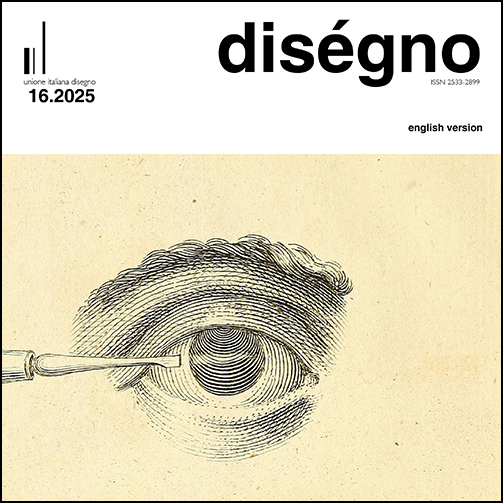Drawing as Language in Panoramic Sketches Created During the Spanish Civil War
DOI:
https://doi.org/10.26375/disegno.16.2025.12Keywords:
landscape, graphic expression, Spanish Civil War, territory, chorographiesAbstract
The article focuses on the analysis of panoramic sketches drawn during the Spanish Civil War in Aragón. These sketches are perspective drawings that depict the warfront landscape as perceived by combatants from strategic positions on both sides of the contact line.
They are elongated graphic documents, generally of large dimensions, created by specialists integrated into the participating Spanish and Italian troops.
These sketches are part of the cartographic material necessary for the meticulous study of the terrain where military actions took place. The prolonged stagnation of the front in Aragón allowed for precise delineation of the relief profiles and the placement of positions, trenches, and fortifications. The sketches served as a means of communication between the message sender, the draftsman, and the receiver, who projected operations onto the territory.
The technical quality of the documents and the validity of the transmitted message are evaluated. The authors’ ability to express the complexity of the territory through the language of drawing is assessed. The phases of their creation and their characteristics are investigated. Additionally, the calculation procedures, graphic techniques used, and methods available for obtaining duplicates are analyzed.
References
Barbadillo, P. (1999). Dibujar. Aprender y pensar. Aprender a pensar. San Lorenzo del Campo Grande: Ediciones Arquna.
Ching, F.D.K., Juroszek, S.P. (2007). Dibujo y proyecto. Barcelona: Gustavo Gili.
Elía-García, S., Ruiz-Varona, A., Temes-Cordovez, R. (2023). Líneas en el frente. El dibujo como arma durante la Guerra Civil Española en Aragón. En EGA Revista de Expresión Gráfica Arquitectónica, N. 28(49), pp. 120-137. <https://doi.org/10.4995/ega.2023.19410> (accessed 28 May 2025).
Gómez de Salazar, F. (1911). Principios y reglas fundamentales de perspectiva lineal. Toledo: Academia de Infantería e Instituto Geográfico y Estadístico.
González de la Vera, L. (1912). El croquis panorámico: aplicaciones militares del dibujo de paisaje. Burgos: Imprenta Marcelino Miguel.
González Presencio, M. (1992). Fórmulas en figuración. Sobre la percepción y representación de las formas. En J. Lorda Iñarra, I. Jiménez Caballero (Eds.). El arte como oficio. VIII Seminario Artes Plásticas Nestlé, pp. 89-90. Pamplona: Universidad de Navarra.
Jiménez Caballero, I. (1992). El medio de la creatividad: el dibujo. En J. Lorda Iñarra, I. Jiménez Caballero (Eds.). El arte como oficio. VIII Seminario Artes Plásticas Nestlé, p. 18. Pamplona: Universidad de Navarra.
Maldonado, J.M. (2007). El Frente de Aragón. La Guerra Civil en Aragón (1936-1938). Zaragoza: Mira editores.
Nadal, F., Urteaga, L. (2013). Mapas y cartógrafos en la Guerra Civil española (1936-1939). Madrid: Centro Nacional de Información Geográfica.
Panofsky, E. (1999). La perspectiva como forma simbólica. Barcelona: Tusquets. [First ed. Die Perspektivw als “symbolische Form”. Leipzig-Berlin 1927].
Prats, F. (1937). Conocimientos topográficos para campaña. Madrid: Defensa Nacional.
Seguí de la Riva, J. (1993). Anotaciones acerca del dibujo en la Arquitectura. In EGA Revista de Expresión Gráfica Arquitectónica, No. 1, pp. 5–14. <https://cartotecadigital.icgc.cat> (accessed 28 May 2025).
Downloads
Published
How to Cite
Issue
Section
License
Copyright (c) 2025 diségno

This work is licensed under a Creative Commons Attribution 4.0 International License.






